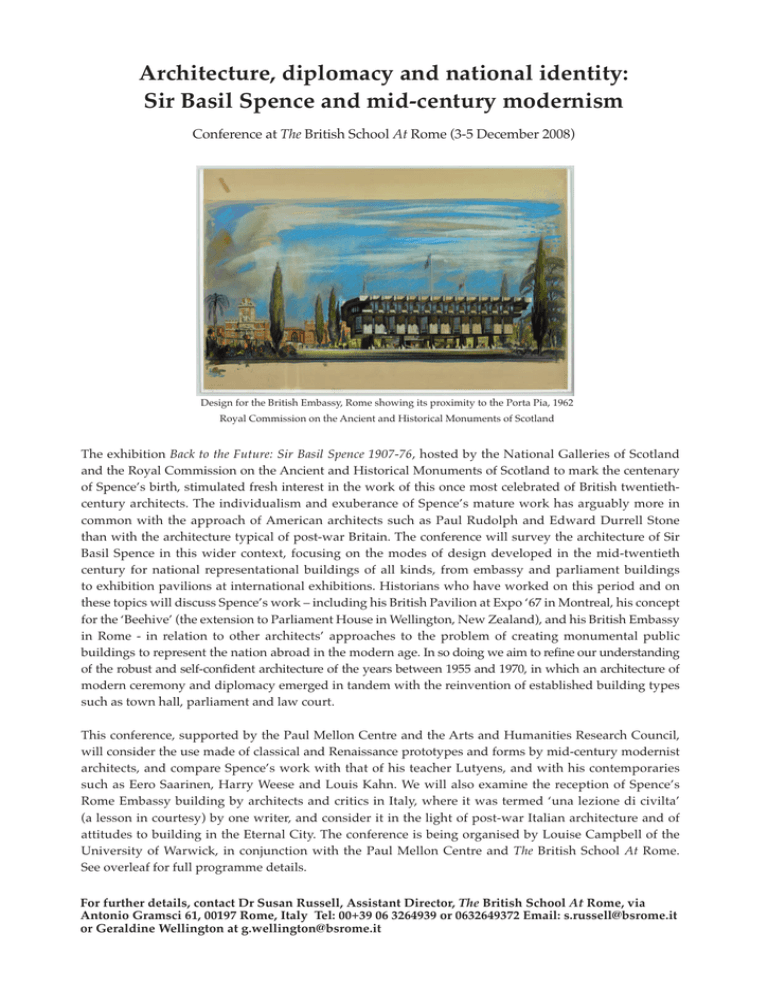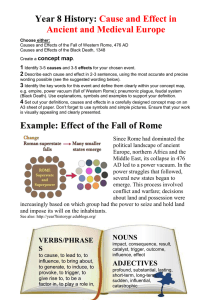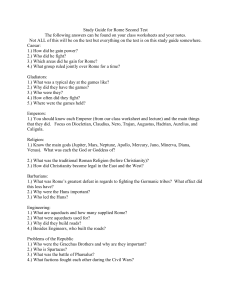Architecture, diplomacy and national identity: Sir Basil Spence and mid-century modernism The
advertisement

Architecture, diplomacy and national identity: Sir Basil Spence and mid-century modernism Conference at The British School At Rome (3-5 December 2008) Design for the British Embassy, Rome showing its proximity to the Porta Pia, 1962 Royal Commission on the Ancient and Historical Monuments of Scotland The exhibition Back to the Future: Sir Basil Spence 1907-76, hosted by the National Galleries of Scotland and the Royal Commission on the Ancient and Historical Monuments of Scotland to mark the centenary of Spence’s birth, stimulated fresh interest in the work of this once most celebrated of British twentiethcentury architects. The individualism and exuberance of Spence’s mature work has arguably more in common with the approach of American architects such as Paul Rudolph and Edward Durrell Stone than with the architecture typical of post-war Britain. The conference will survey the architecture of Sir Basil Spence in this wider context, focusing on the modes of design developed in the mid-twentieth century for national representational buildings of all kinds, from embassy and parliament buildings to exhibition pavilions at international exhibitions. Historians who have worked on this period and on these topics will discuss Spence’s work – including his British Pavilion at Expo ‘67 in Montreal, his concept for the ‘Beehive’ (the extension to Parliament House in Wellington, New Zealand), and his British Embassy in Rome - in relation to other architects’ approaches to the problem of creating monumental public buildings to represent the nation abroad in the modern age. In so doing we aim to refine our understanding of the robust and self-confident architecture of the years between 1955 and 1970, in which an architecture of modern ceremony and diplomacy emerged in tandem with the reinvention of established building types such as town hall, parliament and law court. This conference, supported by the Paul Mellon Centre and the Arts and Humanities Research Council, will consider the use made of classical and Renaissance prototypes and forms by mid-century modernist architects, and compare Spence’s work with that of his teacher Lutyens, and with his contemporaries such as Eero Saarinen, Harry Weese and Louis Kahn. We will also examine the reception of Spence’s Rome Embassy building by architects and critics in Italy, where it was termed ‘una lezione di civilta’ (a lesson in courtesy) by one writer, and consider it in the light of post-war Italian architecture and of attitudes to building in the Eternal City. The conference is being organised by Louise Campbell of the University of Warwick, in conjunction with the Paul Mellon Centre and The British School At Rome. See overleaf for full programme details. For further details, contact Dr Susan Russell, Assistant Director, The British School At Rome, via Antonio Gramsci 61, 00197 Rome, Italy Tel: 00+39 06 3264939 or 0632649372 Email: s.russell@bsrome.it or Geraldine Wellington at g.wellington@bsrome.it Conference Programme Wednesday 3rd December 18.00 18.15 Welcome by Professor Andrew Wallace-Hadrill, Director of The British School At Rome, and Professor Brian Allen, Director of the Paul Mellon Centre for Studies in British Art Plenary Lecture - Professor Gavin Stamp (Independent scholar, London) Lutyens and Spence Thursday 4th December 9.45 Introductory remarks - Dr. Louise Campbell (University of Warwick) 10.30 Professor Eeva-Liisa Pelkonen (Yale University) Eero Saarinen: three embassies 9.50 11.10-11.40 11.40 12.20 13.00 14.30-15.10 15.10-15.50 15.50-16.20 16.20-16.40 16.40-18.00 Professor Jane Loeffler (University of Maryland) Architecture of Diplomacy: the Changing Face of America Abroad Morning Break Dr. Robin Skinner (Victoria University of Wellington) Sorting out the hornets’ nest: Sir Basil Spence and the New Zealand Parliament building Professor Brian Edwards (Edinburgh College of Art) Spence at Expo ’67: modernism and the search for national identity Lunch Break Dr. Miles Glendinning (Edinburgh College of Art) A Modern Palazzo: Designing and Building the Rome Embassy Professor Maristella Casciato (University of Bologna) Neo-Liberty and post-war architecture in Italy Afternoon Break Professor Giorgio Piccinato (University of Rome) Rome in the fifties: architecture and ideology Discussion





